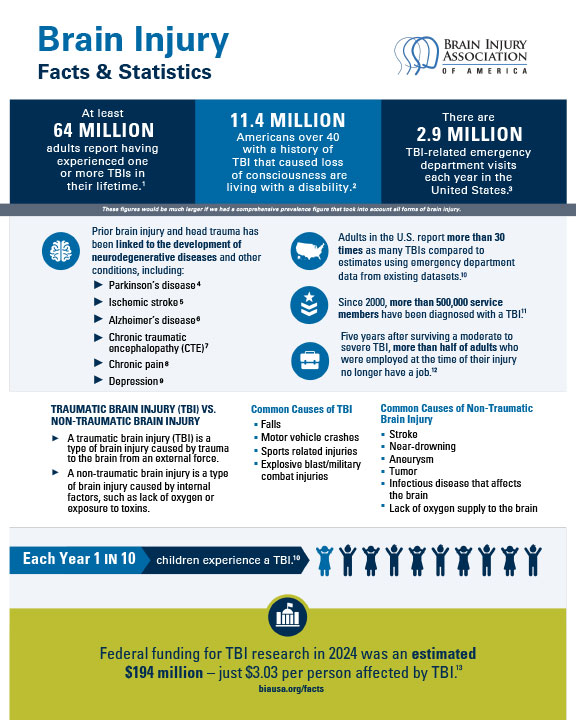Brain injury is unpredictable in its consequences. Brain injury affects who we are, the way we think, act, and feel. It can change everything about us in a matter of seconds. The most important things to remember:

A head may be bumped, hit, jolted or penetrated during a variety of accident types. According to the CDC, falls are the leading cause of TBIs every year. They account for 40 percent of all traumatic brain injuries in the United States.
The second-leading cause of traumatic brain injuries is being hit by an object, or blunt trauma. Motor vehicle crashes are the third-leading cause of traumatic brain injuries, comprising 14 percent of all TBIs. The fourth leading cause of traumatic brain injuries in the U.S. is assault.
While the above may be the most common causes of traumatic brain injuries, they are not the only ones. A brain injury may also occur from an accident while playing sports, a motorcycle accident, a pedestrian or bike accident or from an oxygen deprivation accident such as a near-drowning experience. Shaking a baby violently can also cause a traumatic brain injury, known as “shaken baby syndrome” when referring to infants.
The signs and symptoms of a brain injury can vary greatly depending on whether a brain injury is mild, moderate or severe. The following are physical, sensory and cognitive symptoms to pay attention to:
Usually, one of the first signs of a mild to moderate brain injury, according to the Mayo Clinic, is the loss of consciousness for a brief moment or a few seconds. If loss of consciousness does not occur, then the victim may report feeling dazed or may appear to be confused or disoriented. Other physical symptoms are:

In addition to physical symptoms, a victim and his or her family should also stay on the lookout for sensory and mental signs of a brain injury, too. These include:

Many moderate to severe brain injuries will share the same symptoms of mild to moderate brain injuries. However, the more serious the brain injury type, the more developed and prolonged are the symptoms.
For example, rather than losing consciousness for a few seconds, a moderate to severe brain injury may be characterized by a loss of consciousness of a few minutes or even a few hours. Further, rather than mild nausea, a person suffering from a severe TBI may experience uncontrollable vomiting.
Other symptoms of a more serious brain injury are:

The mental and sensory complications of a more serious traumatic brain injury are also more pronounced. Confusion may be profound, and a TBI victim may be unable to speak lucidly and form sentences and may slur speech.
A severe form of TBI may also render the victim unable to remember important details about the accident or about himself or herself such as his or her name or the day of the week. The person may also demonstrate extreme aggressiveness or agitation and may fall into a coma that persists for an extended duration of time.
When most people think of brain injuries, they usually associate them with some sort of physical impact such as a car accident or an injury sustained in military combat. But there is another class of brain injuries known as an acquired brain injury.
An acquired brain injury (ABI) can be the result of an illness, oxygen deprivation, metabolic disorders, aneurysms, cardiac arrest, near-drowning experience, etc. In short, it includes injuries to the brain that are not caused by an external physical force to the head. Other nonviolent circumstances like tumors and lead poisoning can also injure the brain.
Even though the effects of an ABI are comparable to those affiliated with a TBI, there are some dramatic differences. Previously mentioned and most important, they do not feature any outer blow to the head. ABI also has a direct impact on cells throughout the brain. Because it attacks the cellular structure, a non-traumatic brain Injury has the ability to spread to all areas of the brain as opposed to TBI, which only affects concentrated areas.

A traumatic brain injury (TBI) is defined as a blow or jolt to the head or a penetrating head injury that disrupts the function of the brain. Not all blows or jolts to the head result in a TBI.
The severity of such an injury may range from "mild," i.e., a brief change in mental status or consciousness to "severe," i.e., an extended period of unconsciousness or amnesia after the injury. A TBI can result in short or long-term problems with independent function.
A traumatic brain injury, or TBI, is defined by the Centers for Disease Control and Prevention (CDC) as a “bump, blow or jolt to the head or a penetrating head injury that disrupts the normal function of the brain.” Traumatic brain injury can range in severity from mild (brief change in mental state or consciousness) to severe (extended duration of unconsciousness).
A traumatic brain injury can affect a person physically, cognitively and emotionally. The CDC states that TBI can impair:

The brain is divided into main functional sections, called lobes. These sections or brain lobes are called the Frontal Lobe, Temporal Lobe, Parietal Lobe, Occipital Lobe, the Cerebellum, and the Brain Stem. Each has a specific function as described below.

Frontal Lobe
Parietal Lobe
Occipital Lobe
Cerebellum Lobe
Temporal Lobe
Brain Stem
Questions and Answers About Medicare for Caregivers (152 KB)
Challenges, Changes & Choices: A Brain Injury Guide for Families and Caregivers (377 KB)
